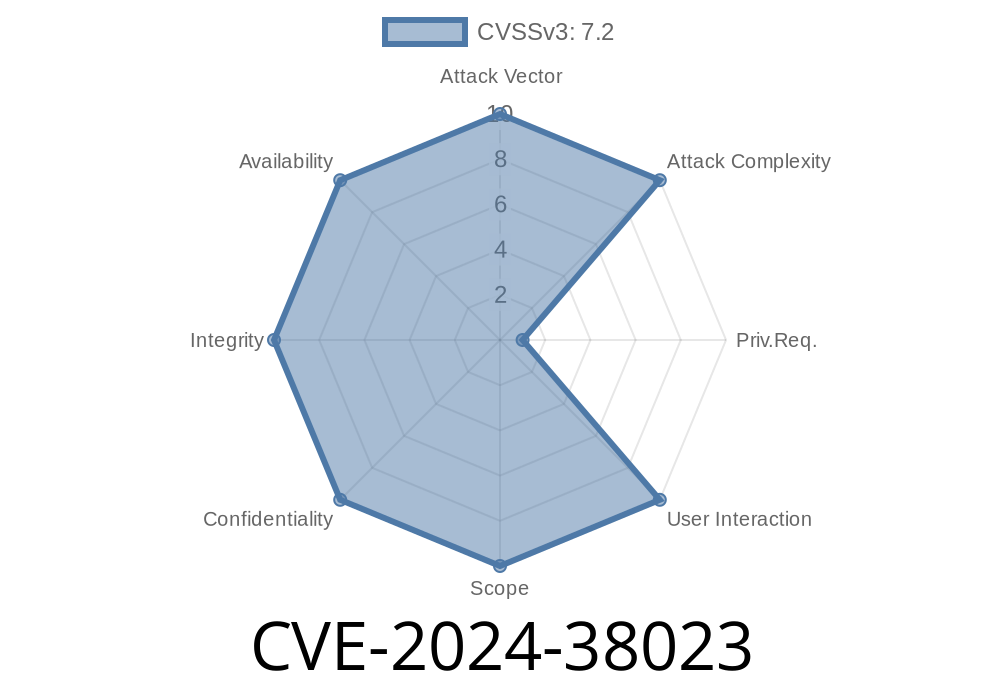Crafted for IT administrators, developers, and security professionals, this long read post delves into a critical vulnerability discovered in Microsoft SharePoint Server. Designated as CVE-2024-38023, this security flaw allows a remote attacker to execute arbitrary code on the underlying system. With numerous organizations using SharePoint Server to manage and collaborate on important documents, threat actors could exploit this vulnerability, leading to catastrophic damage. Comprehending the intricacies of this vulnerability is paramount for safeguarding your network.
This post will provide an in-depth explanation of CVE-2024-38023, including the exploit's mechanisms and repercussions. Additionally, we will demonstrate sample code snippets and furnish you with necessary links to original references. Armed with this knowledge, you can better protect your organization by understanding and addressing this vulnerability with urgency.
Vulnerability Details
CVE-2024-38023 stems from a missing access control mechanism in the SharePoint Server's front-end application pages. This loophole enables unauthenticated attackers to bypass the front-end access controls and abuse certain back-end server APIs, resulting in arbitrary code execution.
Imagine a scenario where your organization's SharePoint Server hosts a vast array of confidential documents and data. An attacker could potentially exploit CVE-2024-38023 to burrow into your network and execute commands remotely, thereby stealing sensitive information or implanting malware.
Original References
- CVE details: https://cve.mitre.org/cgi-bin/cvename.cgi?name=CVE-2024-38023
- National Vulnerability Database (NVD): https://nvd.nist.gov/vuln/detail/CVE-2024-38023
- Microsoft Security Advisory: https://portal.msrc.microsoft.com/en-US/security-guidance/advisory/CVE-2024-38023
Exploit Mechanics
Typically, Microsoft SharePoint Server employs sufficient access controls to secure its sensitive application pages from unauthorized users. However, with CVE-2024-38023, a missing access control element leaves the entry point exposed.
For instance, here's a code snippet that demonstrates how a server API request is made using a user's authentication token:
POST https://<sharepoint_server>/_api/web/GetFileByServerRelativePath(decodedurl='folder/file.docx')
Headers:
Accept: application/json;odata=verbose
Content-Type: application/json;odata=verbose
X-RequestDigest: <authentication_token>
But when an unauthenticated attacker leverages CVE-2024-38023, they can exploit the SharePoint Server without the need for an authentication token.
POST https://<sharepoint_server>/_api/web/GetFileByServerRelativePath(decodedurl='folder/file.docx')
Headers:
Accept: application/json;odata=verbose
Content-Type: application/json;odata=verbose
As illustrated above, the attacker bypasses the need for authentication by eliminating the X-RequestDigest header. Consequently, the attacker gains complete control over the SharePoint Server and can execute arbitrary code.
Mitigation Steps
To address CVE-2024-38023, Microsoft has released security updates for the vulnerable SharePoint Server versions. It is strongly advised that you apply these updates immediately by visiting the Microsoft Security Advisory link listed in the Original References section.
In addition, adhere to the best practices listed below to better protect your network against such exploits:
Conclusion
CVE-2024-38023 is a high-severity vulnerability in Microsoft SharePoint Server that demands immediate attention. By understanding the exploit mechanics and implementing necessary security measures, you can shield your organization against cyber threats and uphold a robust security posture.
Timeline
Published on: 07/09/2024 17:15:28 UTC
Last modified on: 07/18/2024 23:02:37 UTC
